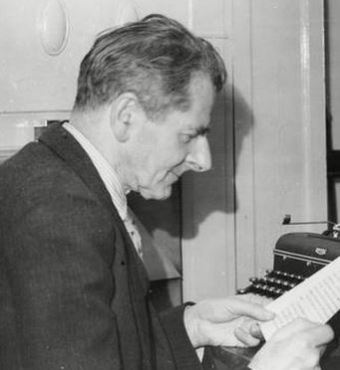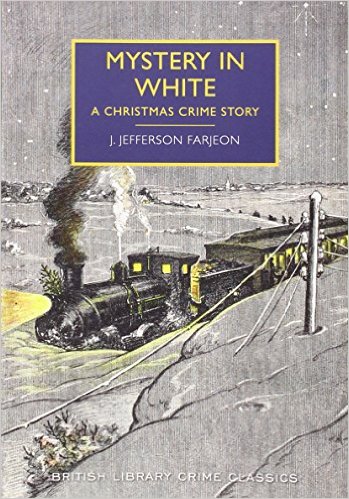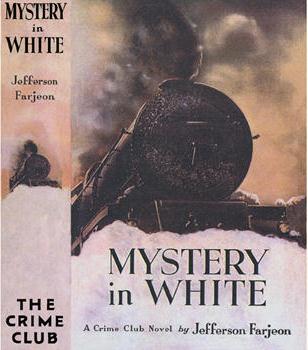I had it all planned out, I swear. I had picked up from a local bookstore two classic Christmas mysteries recently revived by The British Library – J. Jefferson Farjeon’s Mystery in White ands Mavis Doriel Hay’s The Santa Klaus Murder – and had intended to provide convivial fun over the holidays with a singularly Jewish take on Yuletide mayhem. But time! Time, my friends! Time eats away at the best of our intentions, and I had to let the idea – and the novels – hibernate until next winter.
But then my impetuous pal JJ at The Invisible Event had the audacity to aver that the confluence of all things great about the Golden Age of Detection occurred in the year 1937. And then Rich at Past Offenses took up the call by making 1937 his “year of the month”. And there was that 1937 Farjeon title, Mystery in White, tucked deep within my TBR pile, snoring away. So I thought, “I’m home with a cold, so perhaps, as Auntie Mame sings, “We need a little Christmas now.”

Other bloggers can set me straight, but I vaguely seem to recall hearing that Mystery in White was one of the first classic mystery titles resuscitated under the British Library Crime Classics imprint, and its surprising, though much welcome, success has paved the way for more. I have seen many positive reviews, so I was looking forward to this read. It was penned by Joseph Jefferson Farjeon, one of those prolific but now forgotten authors that everyone used to read! How fine of the British Library to give us access to this, and other, Farjeon titles!
I have to say, you can do a lot worse than a book like this when you’re housebound with a slight fever, chowing down on homemade chicken soup and Mucinex. The novel reads like a breeze, with delightful characters having charming conversations. It felt deeply nostalgic and reminded me of when I was a boy, and my grandmother and her two sisters would take me to lunch downtown at Townsend’s Restaurant. They served a great creamed spinach with hard-boiled egg, which I would gobble down while the Three Sisters would chatter all at the same time: Aunt Louise about her grandchildren, Aunt Bernice about the precarious state of her health, and my grandmother Fay about growing up in San Francisco, the oldest (and the favorite) of the three sisters.

In the early stages of Mystery in White, the writing exudes the same old-fashioned charm and humor that these ladies did. A small, disparate group of British citizens find themselves stranded by a thick snowfall on a commuter train. They include a dashing pair of siblings, David and Lydia, who remind me a little of Jerry and Joanna Burton from Christie’s The Moving Finger, an old man named Mr. Maltby who belongs to the Royal Psychical Society – so he may be wise or he may be wacky – and is on his way to some unknown destination to converse with King Charles I, and a petulant bore named Mr. Hopkins. There is also a lovely portrayal of a chorus girl that avoids all the clichés we’ve read about chorus girls. This one, Jessie, is quite aware of the power of the chorus girl over men, a fact that she bemoans throughout the book, both in thought and in her diary:
“She was well aware of both her power and the limitation of her power, and while the power, despite its small thrills, gave her a secret dread, the limitation was a secret sorrow. How wonderful to be able to conquer a man, wholly and eternally, instead of being just an ephemeral taste.”
Another character is Mr. Thomson, a colorless young accountant with a burgeoning cold (how I empathized with him!) on the way to a dull Christmas with a dreaded aunt. Although he sadly spends most of the novel unconscious with fever, his inner thoughts offer a funny and touching look at the fantasy life of a nebbish:
“Often, in his imagination, he came upon a lady aviator who had had a crash, and after lifting her gently from the wreckage, he carried her to a small empty cottage, made her tea, and married her.”
These six while away the time conversing about what to do when suddenly, Mr. Maltby rises and dashes out of the compartment and off the train. David,Lydia, Jessie and Mr. Thomson decide to follow, and they all end up in a large house carefully laid out for company yet unaccountably empty. Besides the roaring fires and the boiling tea kettle, the only ominous sign is a knife on the kitchen floor . . .
It’s a great set-up, and that, along with its effortlessly readable style, reminded me of early Christie. So I would be hard put to go all ballistic on this book. It’s like a fluffy raspberry mousse: stir it too hard and the gelatin collapses and you’re stuck with a bowl of sticky sweet goo. I don’t mean that the book is gooey; it’s just that Mystery in White perhaps deserves a lighter touch. Martin Edwards, in his introduction to the novel, tried to warn me:
“ . . . despite some similarity in the initial set-up, Farjeon’s story, first published in 1937, really owes nothing in terms of structure of solution to Agatha Christie’s classic Murder on the Orient Express, which appeared three years earlier.”
Or,
“Having created expectations in the reader of one kind of detective story, Farjeon promptly disrupts them by directing events down a very different track.”
All of this is absolutely true, but I still felt that, given that we start in a train, which does end up being the scene of a murder, and that we end up in a country mansion on Christmas Eve in England in 1937 when JJ swears the classic mystery was at its peak (!!!) . . . that somewhere down the line I was in for a classic mystery. And that is simply not what this book is all about. Oh, there is a mystery as to what is going on, and a detective of sorts who gets it all sorted out at the end, and a lot of people are dead and order is restored. But given the company we’re in, a certain number of tropes were expected, (by me, at least) and these are not what Farjeon sets out to deliver.

Mystery in White strikes me more as a comforting British novel full of nice people you want to spend time with, but there’s some criminal stuff on the fringes that needs to be sorted out before we can all eat and open our presents. Everyone here is nice. Even Mr. Hopkins, the bore, veers from obnoxious to adorable by the end. There are some very unnice people in the story, but most of their machinations occur very offstage, both in terms of time and space. This is not the novel to pick if you want that luscious GAD moment of somebody being unmasked. No point complaining about that! It’s just not that kind of story.
The odd thing is, since we are not dealing with the typical structure of a 30’s whodunit, then there are surprises to be had. For instance, we get teased a lot about the potential romantic relationships brewing among the characters, and I have to say that it all ended up a bit differently than I expected. Then there’s the matter of Mr. Maltby’s psychic abilities, which formed one of the most interesting aspects of the book. I’ve always thought that an effective psychic would make a great detective because they know how to read people. After all, they have to do so since there’s no such thing as ghosts, right? Maltby argues convincingly as to the true nature of “ghosts,” so that one could posit that his solving of the situation is a combination of logic, reading character through both action and setting, and a reading of “emanations recreated by acute living sensitiveness or intelligence from the inexhaustible store-houses of the past.” I had to read that last bit several times. I have to admit I figured Mr. Maltby would be exposed as a fraud at some point. But this was just one of many examples of my misreading the direction things were going in based on my foreknowledge of GAD tropes.
The author provides a wonderful sense of atmosphere throughout, both in the abandoned house, whose warm coziness belies a sense of darkness and danger that touches even the least sensitive of the houseguests, and in the harrowing, claustrophobic scenes set in the blinding snow. The fact that the mystery itself essentially occurs offstage negates much of the suspense one should find in a more traditional mystery, and the novel is almost completely lacking in a true puzzle element, although Maltby makes interesting deductions about the people and events around him based on his “psychic ability.” Some new characters make a late appearance in the proceedings, and my main complaint here is that my favorite characters, like Jessie, start to become extraneous. In fact, the women here, though thoroughly delightful every one of them, don’t get to do very much.

The question is: if someone had sold this book to me more as a “lighthearted adventure in crime,” would I have bitten? Maybe not. I was sold by the set-up and by the allusions to Christie. Martin Edwards writes, “Rather than following in Christie’s footsteps, Farjeon was, in fact, anticipating the mise en scene of her short story ‘Three Blind Mice.’” In hindsight, this feels a bit misleading to me. Farjeon’s novel is like “The Mousetrap” only in that both take place in a snowbound mansion. So don’t open this novel expecting a serial killer or a group of suspicious character peering at each other through keyholes. The clearest expectations one would find here are stated by Mr. Edwards at the end of his introduction:
“For all the chill of the Christmas-time snow in Mystery in White, there are repeated clues to Farjeon’s amiable personality in the good humor that shines through from start to finish.”
And indeed, the character of Lydia exists primarily to ensure that, despite the dastardly goings-on all around them, everyone will ultimately have a happy Christmas. Go into this novel expecting to be thus reassured, not baffled, and you will manage just fine. If anything, Mystery in White bears all the markings of a classic British ghost story, and I mean that in the best sense of the word. There’s something slightly Christmas Carol about the whole affair, right down to the redemption through tribulation of mean Mr. Hopkins.
Thus, I do recommend my first foray into the writing of the prolific yet forgotten J. Jefferson Farjeon as a light and enjoyable read. Meanwhile, I need to move on to deeper mysteries if I am going to come close to siding with JJ on the 1937 issue!
I know just the sort of setup you mean, Brad, and it does sound appealing! And very GA. The story sounds interesting, too. As I was reading your post, I was wondering why it is that some authors are remembered for a very long time, even if their work isn’t great. Others, though, are quickly forgotten, even if their work is. I’m not saying that Farjeon necessarily falls into either those categories, just that they’re there. Glad you found things to like about this one, and I do hope you feel better soon.
LikeLike
Here’s hoping the fever passes soon and that no major amputations are required.
I was a lot less taken by Mystery in White than most, and part of my disappointment (it was a while ago) may well have been because I went into it expecting a mystery. The fact that, about halfway through, I realized I’d read it back in the mid-1980s or so and been unimpressed by it didn’t help either!
LikeLiked by 1 person
Yeah Farjeon doesn’t really do traditional detective mysteries a lot and when he does he doesn’t seem as comfortable as when he is doing a thriller. Mystery writing with thriller slant is more his style. Mystery in White is probably my favourite Farjeon novel. He also wrote a series involving a tramp named Ben. Again with this series they are more thriller, with Ben walking into criminal plots and trying to extricate himself from them. The one I read last year was quite interesting and due to Ben’s social status gives a more unusual milieu. Hope Mimi and Sonny are taking good care of you and that you get better soon.
LikeLike
Sounds like a good read for when you don’t feel well. I’ve got it sitting on my TBR pile as well. I’m sure I’ll enjoy the good humor “shining through.”
LikeLike
It’s interesting that this was the first really big seller in the BL series — shifting, I seem to remember, some 70,000 copies in the run up to Christmas 2015 — especially when you consider how unconventional it is. Perhaps it inspires an idea that these sorts of books have hokey aspects that are conveniently ignored like Maltin’s psychic ability, I dunno. But it’s undoubtedly paved the way for a lot of what has followed in this series and elsewhere…no mean feat!
LikeLiked by 1 person
I found it fascinating that Farjeon kept the source of Maltby’s insight ambivalent. At one point, he “channels” a dead man and speaks in his voice, clearing up a past mystery. Maltby never confirms that this was just a ruse to drum out the truth, and he’s one character whose inner thoughts we never explore. I know that psychics were the rage in the early 20th century, but in mysteries they existed to be debunked! A heroic psychic SHOULD let us in on his “fakery,” but Maltby insists he’s attuned to past “vibrations.” The important thing is that it lets Farjeon off the hook from explaining how Maltby knew where the fortune was hidden – and seriously lessens the book’s status as a certain type of classic mystery. Jessie has the “sight” too, knowing instinctively where evil has been done in the house. The whole thing was great fun, but I wouldn’t want to read a lot of these. But it’s great that the book’s success paved the way for other authors and titles.
LikeLiked by 1 person
Its helpful to hear you place this within the light hearted thriller/mystery rather than a GAD novel as I wasn’t really sure where Farjeon was sitting.
Although it’s a shame in a lot of ways as the set up for this as well as 13 Guests (etc) all sound so brilliant, and would make great straight detective stories.
LikeLiked by 1 person
Unfortunately, from what I’ve read of others’ opinions, 13 Guests sounds like a less promising read for me.
LikeLiked by 1 person
Yeah, they seem like frustrating reads for most!
LikeLike
It isn’t the best mystery ever written, and that train on the cover is misleading, as they all leave it very early on – but I think we can all warmly welcome the interest it provoked in classic crime. I remember when it first came out standing in a nice independent bookshop and seeing a table full of it, and actually watching people’s attention being grabbed. You could SEE them thinking ‘oh this will make a good Xmas present for someone or other’ and then watch them take it to the till. It was a sight to warm the heart…
LikeLiked by 1 person
Yeah, you can’t knock it for its PR value alone!! 🙂
LikeLike
Pingback: ‘The biggest group of red herrings’: #1937book roundup | Past Offences: Classic crime, thrillers and mystery book reviews